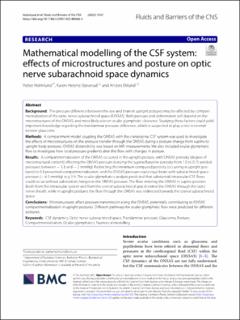| dc.contributor.author | Holmlund, Petter | |
| dc.contributor.author | Støverud, Karen-Helene | |
| dc.contributor.author | Eklund, Anders | |
| dc.date.accessioned | 2023-02-24T12:39:48Z | |
| dc.date.available | 2023-02-24T12:39:48Z | |
| dc.date.created | 2022-10-05T13:26:13Z | |
| dc.date.issued | 2022 | |
| dc.identifier.citation | Fluids and Barriers of the CNS. 2022, 19, 67. | en_US |
| dc.identifier.issn | 2045-8118 | |
| dc.identifier.uri | https://hdl.handle.net/11250/3053895 | |
| dc.description.abstract | Background:
The pressure difference between the eye and brain in upright postures may be affected by compartmentalization of the optic nerve subarachnoid space (ONSAS). Both pressure and deformation will depend on the microstructures of the ONSAS, and most likely also on ocular glymphatic clearance. Studying these factors could yield important knowledge regarding the translaminar pressure difference, which is suspected to play a role in normal-tension glaucoma.
Methods:
A compartment model coupling the ONSAS with the craniospinal CSF system was used to investigate the effects of microstructures on the pressure transfer through the ONSAS during a posture change from supine to upright body postures. ONSAS distensibility was based on MRI measurements. We also included ocular glymphatic flow to investigate how local pressure gradients alter this flow with changes in posture.
Results: A compartmentalization of the ONSAS occurred in the upright posture, with ONSAS porosity (degree of microstructural content) affecting the ONSAS pressure (varying the supine/baseline porosity from 1.0 to 0.75 yielded pressures between − 5.3 and − 2 mmHg). Restricting the minimum computed porosity (occurring in upright postures) to 0.3 prevented compartmentalization, and the ONSAS pressure could equilibrate with subarachnoid space pressure (− 6.5 mmHg) in ≤ 1 h. The ocular glymphatics analysis predicted that substantial intraocular-CSF flows could occur without substantial changes in the ONSAS pressure. The flow entering the ONSAS in supine position (both from the intraocular system and from the cranial subarachnoid space) exited the ONSAS through the optic nerve sheath, while in upright postures the flow through the ONSAS was redirected towards the cranial subarachnoid space.
Conclusions: Microstructures affect pressure transmission along the ONSAS, potentially contributing to ONSAS compartmentalization in upright postures. Different pathways for ocular glymphatic flow were predicted for different postures. | en_US |
| dc.language.iso | eng | en_US |
| dc.publisher | BMC | en_US |
| dc.rights | Navngivelse 4.0 Internasjonal | * |
| dc.rights.uri | http://creativecommons.org/licenses/by/4.0/deed.no | * |
| dc.title | Mathematical modelling of the CSF system: effects of microstructures and posture on optic nerve subarachnoid space dynamics | en_US |
| dc.title.alternative | Mathematical modelling of the CSF system: effects of microstructures and posture on optic nerve subarachnoid space dynamics | en_US |
| dc.type | Peer reviewed | en_US |
| dc.type | Journal article | en_US |
| dc.description.version | publishedVersion | en_US |
| dc.rights.holder | © The Author(s) 2022 | en_US |
| dc.source.pagenumber | 16 | en_US |
| dc.source.volume | 19 | en_US |
| dc.source.journal | Fluids and Barriers of the CNS | en_US |
| dc.identifier.doi | 10.1186/s12987-022-00366-4 | |
| dc.identifier.cristin | 2058792 | |
| dc.source.articlenumber | 67 | en_US |
| cristin.ispublished | true | |
| cristin.fulltext | original | |
| cristin.qualitycode | 1 | |

